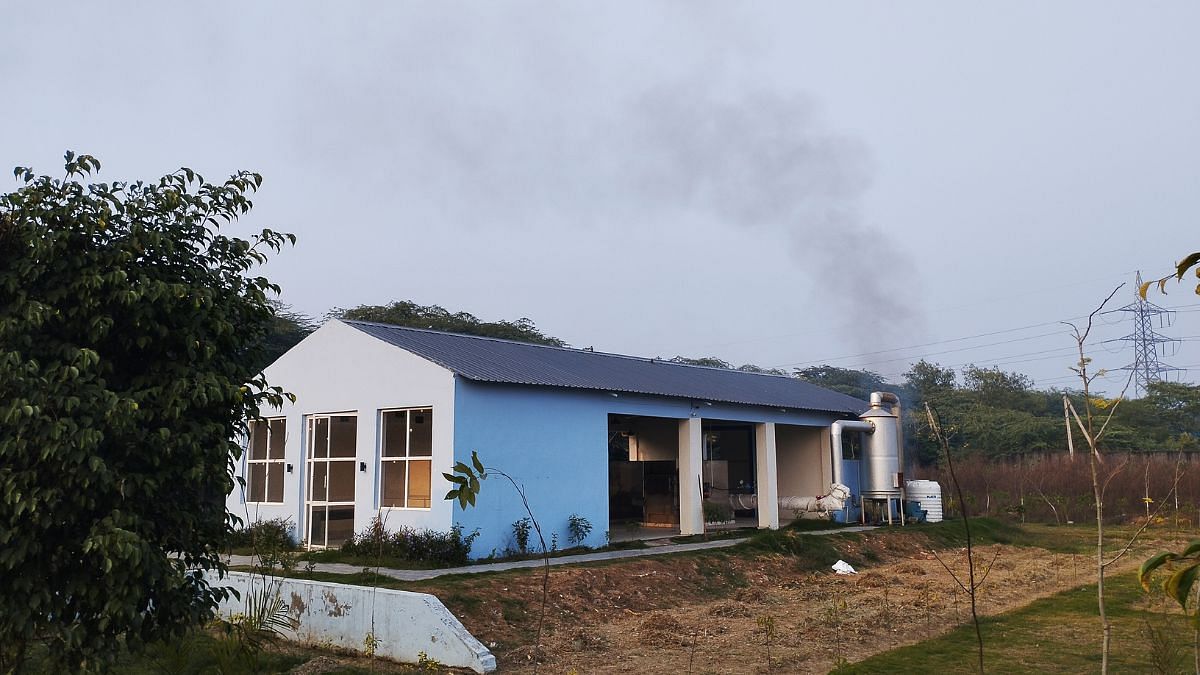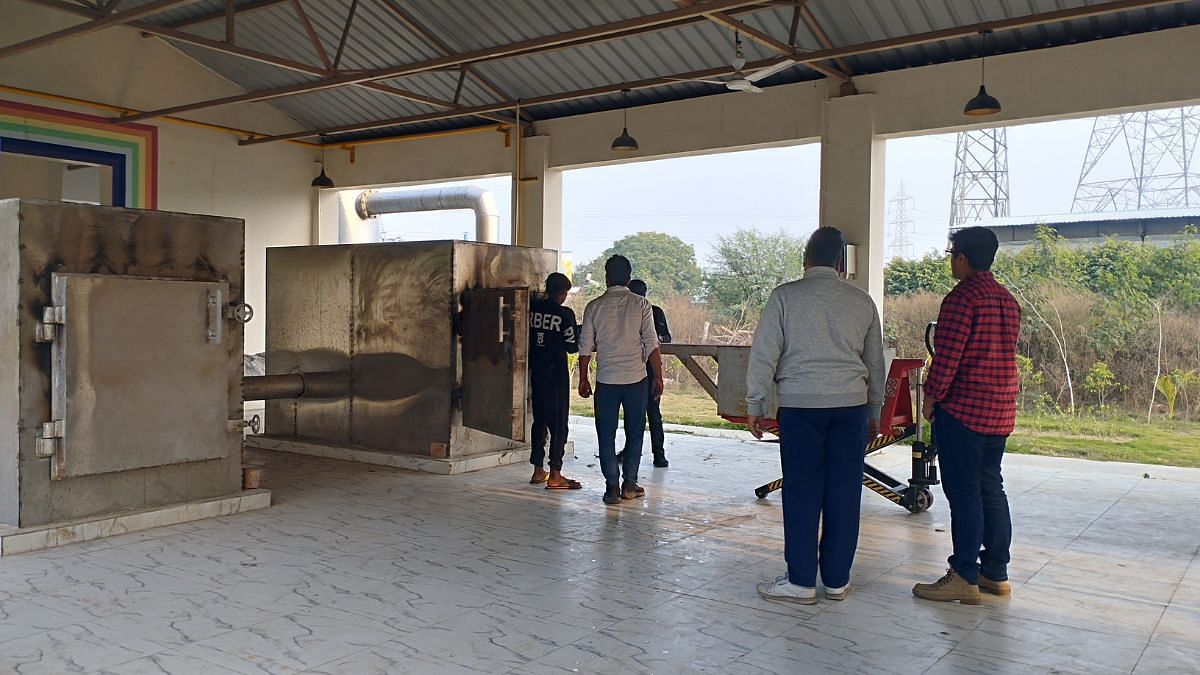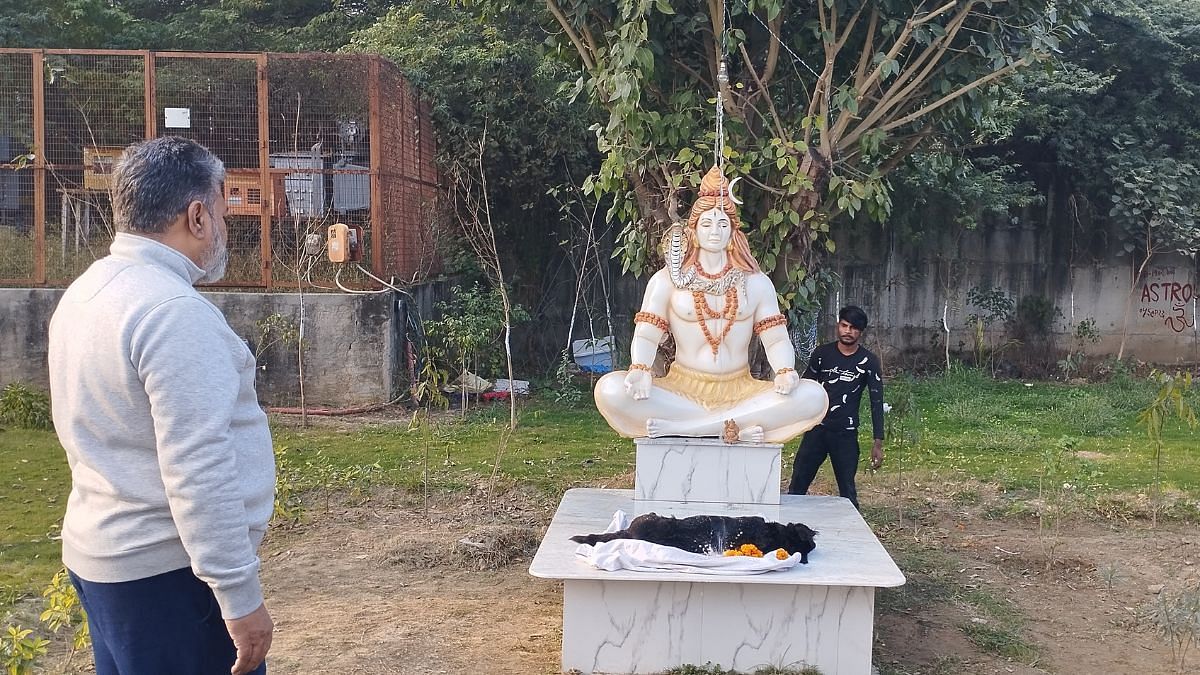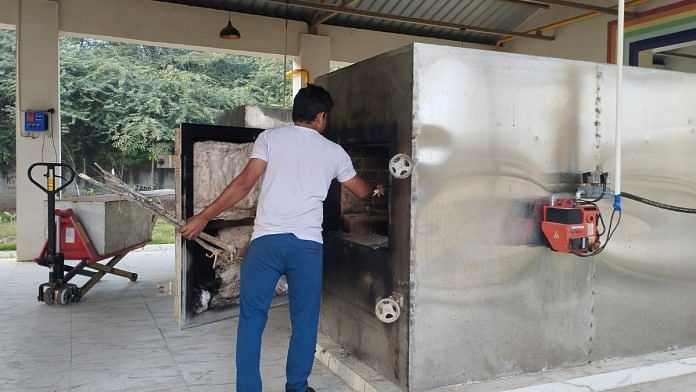Fifty-three-year-old Sanjay Rana, a builder from Dwarka Sector 11, stood heartbroken. His black flat-coated retriever’s body lay on a white marble platform beside the Shiva idol. The fountain from Shiva’s head gently washed the dog’s body. Two helpers placed the dog inside the cremation furnace, and with a heavy heart, Rana pressed the button. Despite the sorrow, there was a sense of satisfaction on his face, knowing he was giving his beloved dog a dignified and eco-friendly final farewell.
Dignity for dead animals is unheard of in India. But that’s what the first pet crematorium run by the Municipal Corporation of Delhi, in partnership with Green Revolution Foundation (GRF), has set out to do. The facility at Dwarka Sector 29 that’s waiting to be inaugurated by Delhi Lieutenant Governor VK Saxena began operations earlier this month and promises to provide pollution-free, timely and ethical cremations to the pet owners. Operational at a modest cost of Rs one crore, the place also houses a memory garden where families are being encouraged to plant a tree, dedicated to their pets. The crematorium claims to meet international standards and offers comprehensive services, including pooja by a priest hired by the GRF.
“People link their own religion and practices to their pets. But animals do not get proper rites in their funeral like humans do. Owners treat them like their family members so they should also get the same treatment,” says Krishan Choudhary (30), who is serving as a veterinary livestock officer at Dwarka’s Furry Friends Forever Memorial Park and Crematorium.

Also read: There’s a new music festival race in Northeast. Dambuk’s OFAM offers 12 genres & rice beer
Starting up
GRF is on a mission to transform Indian crematoriums into environmentally friendly spaces. They are using minimised chimney technology, and have developed efficient and compact incinerators that cremate bodies in quick time when compared to traditional ones, and emit significantly less smoke.
They have also set up a cremation centres in Kukatpally, Hyderabad, which includes a single furnace. It is pending inauguration, and the work is scheduled to commence in January.
At the Dwarka centre, Choudhary oversees a team of five staff members, including an ambulance driver, gardener, cleaner, and two helpers.
The CNG-powered cremation centre spanning 700 square meters has two furnaces, one with a 200kg capacity and the other with 150kg. It has a daily capacity of 25 animal cremation — 10 private pets and 15 small street animals — with each cremation taking more than two hours.
According to The Hindu Business Line report, India has over 32 million pets, and the pet healthcare industry is expected to grow at a CAGR of 3.17 per cent, reaching up to Rs 7,000 crore.
“Right now we are getting less cases. As soon as more people start coming, we will increase the facilities and plan to open more such centres,” said Sahib Sawhney, Managing Director of the GRF.
Choudhary is eagerly awaiting the pending visit of the Lieutenant Governor. This is expected to commence additional services at the centre such as regular ambulance facilities, which is currently limited to emergency cases. A high-profile visit such as by Delhi L-G is likely to create more awareness around this facility and may give Choudhary, who is currently engaged in a door-to-door campaign promoting the centre, a break.
Despite being a novel initiative, the location of the centre doesn’t seem to be in its favour. The place is surrounded by fields on one side, and bordered by trees on the other, draped in the shroud of desolation. Reaching this place even using a map is also challenging.

Also read: Nagaland wants to rule hospitality— 5-star hotels to tribal villages, Delhi to Japan
Cheaper rates, cleaner means
Choudhary is tackling the awareness challenge by visiting vet clinics in Dwarka, local NGOs, besides the door-to-door campaigns once in a week.
He aims to attract more people to his centre because it’s the “best way to say goodbye.”
“Old cremation centres have a strong network due to which they get a lot of pets. And they cremate using wood, which is more harmful for the environment,” says Chaudhary while double-checking the smoke coming out of the furnace.
Animal bones, Choudhary says, are harder than those of humans. Cremations using wood may not effectively burn these bones, resulting in incomplete combustion and increased smoke production, contributing to higher levels of pollution.
“People stand in queues at other cremation centres that keep the bodies waiting. And they don’t complete the cremation process. It’s not a very pleasant experience,” Choudhary added.
At the Dwarka centre, MCD has set cremation rates at Rs 2,000 for animals weighing under 30kg and Rs 3,000 for those who weigh more. And these rates are lower than local private crematoriums in the city that charge anywhere between Rs 5,000-8,000.
They are preserving the memory of pets through their memory garden on the premises. Families are encouraged to plant a tree in honour of their pets, and approximately 30 such cremations have been conducted so far.
The crematorium is surrounded by small plants on all three sides, which are regularly maintained. Near the sterilisation centre that’s close by, there are several such saplings kept for the people who perform the final rites of their animals. Through this, they can keep their “pets alive forever” and see them “growing”. Owners name these plants after their pets.
In many cultures, the process of cremation is not just a means of disposal but a significant ritual that reflects the beliefs and values of the community. Understanding these practices can provide deeper insights into how societies cope with loss.
Also read: Bengali films facing identity crisis. Losing box office battle to Pathaans and RRRs
Practising safety
While CNG is considered a safer option, there are precautions the staff must take. When the cremation is on, Choudhary makes sure everyone keeps their phones away.
“We cannot use cell phones near the furnace because it has some radiation problem due to which there are more chances of explosion,” Choudhary added.
Accessing the furnace without proper safety gear, including gloves, suits, and glasses, is unsafe. But in the absence of two regular helpers who were on leave, Choudhary sought assistance from two people from the nearby dog sterilisation centre to place the retriever’s body into the furnace. Both proceeded with the task but without using any safety gear.
“We have only two furnaces and it’s difficult for us to cover the whole city with this,” Choudhary added.
According to Shawney, there is a provision in their contract with the MCD that allows for the addition of more furnaces if the number of cases increases. If the daily cases reach 25, they will establish additional branches in Delhi.
Shawney plans to establish eco-friendly cremation centres specifically designed for larger animals such as cows and buffaloes.
Also read: Assam is seeing a volleyball revolution. A local champ is rallying one village after another
The idea
It was a personal loss that inspired Sawhney to find a solution to a problem that thousands of pet lovers face in big cities. When his dog Candy died, it was tough for him finding a suitable place to cremate.
Eventually, the 11-year-old labrador had to be cremated at a facility that had no sense of cleanliness and used outdated technology for burning the body. Witnessing his pet being pushed into the insulator “broke his heart and shook him to the core.” He was charged Rs 8,000 for the cremation. Sawhney was upset with the treatment his pet was given during cremation.
In 2020, when the world was in lockdown, Sawhney and the director of the Veterinary Department in MCD spent over a year, carefully planning the project. Sawhney was able to persuade the MCD that “whatever money the municipal body invested in the crematorium, it will be recovered.”
However, Covid and the lengthy process of obtaining permissions, including from the Chief Controller of Explosives for the gas pipeline, delayed the project by a year.
ThePrint contact Dr. VK Singh, Additional Director, Veterinary Department, SDMC, through phone calls and messages but no response was received.
The facility uses an advanced air purification system which means the facility doesn’t need a chimney, making it more sustainable.
It uses a compact design incinerator that reduces the levels of pollution and smoke released into the atmosphere. The incinerator is equipped with advanced, three-stage decarbonisation wet scrubber technology that cleans smoke by settling suspended harmful particles before releasing them into the atmosphere.
There are three types of cremation methods: electric, gas, and wood. Sahwney opted against the use of an electric furnace due to public disapproval and high maintenance costs. People say the use of electric furnace is against the belief system of the Hindus as they don’t involve fire and only generate heat.

“We did not want to do anything that would cause us to face financial crunch in the future or have to stop the project. Gas-based facility was the only solution for us,” he added.
And people are starting to appreciate the initiative.
Rana doesn’t blink his eyes while observing the smoke emanating from the furnace.
“This is the most dignified way to bid farewell to your beloved pet,” says Rana. While taking a deep breath, he inquires about collecting the ashes from Choudhary. He instructs him to come the next morning for the collection.
(Edited by Anurag Chaubey)






